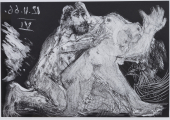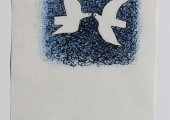Picasso, Braque & Léger:
20TH CENTURY MODERN MASTERS
SEPTEMBER 8-DECEMBER 8, 2013
Picasso, Braque & Léger: 20th Century Modern Masters is on view in The Shelley and Donald Rubin Gallery. This exhibition of more than 80 works introduces viewers to lithographs, etchings and aquatints by three of the 20th century’s modernist leaders.
These fine prints were the result of collaborations or interpretations of major literary works by post WWII writers and poets, such as Le Cocu Magnifique by Fernand Crommelynck and illustrated by Pablo Picasso, Le tir à l’arc published by Louis Broder, Paris, and illustrated by Georges Braque, and Arthur Rimbaud’s poem Fêtes de la Faim illustrated by Fernand Léger.
This exhibition is part of The Shelley & Donald Rubin Exhibition Series and was organized by curator Reilly Rhodes of Contemporary and Modern Print Editions.
Please note: No photography allowed. This exhibition contains mature content.
Select Highlights:
-

Picasso: Visage (face of Marie-Thérèse)
-

Picasso: Viol, Avec un Coq
-

Picasso: Untitled [Face of a Bull]
-

Léger: Portrait de Rimbaud
-

Léger: Fêtes de la faim [Feasts of Hunger]
-

Picasso: Deux Femmes nues (Metamorphoses d’Ovide)
-

Léger: Bonne pensée du matin
-

Braque: Pale Ale
-

Braque: Couple d’oiseaux [Pair of Birds]
Background:
From an early age, Picasso had exceptional talent as an artist. His father a painter taught drawing at the art Academy in Barcelona. At the age of 15 he presented his work to the public for the first time, and at the age of 19 was chosen to exhibit one of his paintings at the Spanish pavilion in the Paris International Exhibition of 1900.
Before settling in Paris to live in 1904, he began illustrating works based on poetry, and he held close friendships with writers and poets interested in modern art in both France and Spain. Printmaking for Picasso was a very important part of his creative process and a constant medium in which he worked throughout his life. At the time of his death in 1974 Picasso had created nearly 2000 etchings, lithographs and linocuts, and illustrated 156 books with original plates.
The earliest dated engraving in the exhibition is Picasso’s Dance Barbare, 1905 from his Les Saltimbanques (The Acrobats). Picasso made the engraving when he was just 24 years old. In the second half of 1904 Picasso’s style exhibited a new direction (his Blue Period lasted from 1900 to 1904). For about a year he worked on a series of pictures featuring harlequins, acrobats, and circus performers. His Family of Saltimbanques appealed to him because he saw their role in society as outcasts at odds with conventional urban culture. His Dance Barbare (or La Dance), and the engraving titled Salomé both show an image of King Herod with the dancer Salomé although in Dance Balrgare Picasso seems to be attempting to create more of their true inner-self image making the figures less appealing to look at. There are a total of eight figures in the Dance Barbare engraving with King Herod and Herodias (Salomé’s mother) are seen in the foreground with a servant offering a platter filled with fruits. The eighth figure, (often overlooked), is the baby being used as a violin by the musician standing to the left of Salomé. At the left stands a youth as an observer—perhaps an artist or poet. Symbolically, the youth is a witness to Salomé’s erotic ‘dance of the seven veils’.
In a letter, dated 1905, to the American art collector Leo Stein, Picasso added a sketch of an amusing dance of King Herod with the title “belle danse baibare” (beautiful dancers). The letter was sent to accept an invitation to see the Steins’ collection of paintings by Paul Gauguin.
In 1947 Picasso collaborated with Albert Gleizes and Jean Metzinger to publish Du Cubisme, explaining the Cubism movement. Picasso contributed an original etching Man With a Hat, 1914 that had not been printed at the time it was made. He said at the time that his Cubist prints were experimental and largely a private affair, with a small number of proofs pulled by the artist from his personal press.
Picasso’s 1927 etching Sculpteur modelant (Sculptor Modeling), was made as an illustration for a publication on Balzac’s ‘Le Chef d’Oeuvre Inconnu’ (The Unknown Masterpiece). The publication consisted of 12 etchings by Picasso and a wood engraving by Georges Albert after a drawing by Picasso. It was Ambroise Vollard who asked Picasso to illustrate Balzac’s text in 1926 and Albert Bernard, a friend of Vollard’s who wrote the preface to the book. Vollard published the etchings in Le Chef d’Oeuvre Inconnu in 1931, the same year that Picasso created another important group of etchings Les Métamorphoses d’Ovide published by Albert Skira. The drypoint etchings are based on the 15 book classic Greek epilogue titled Metamorphoses written by the Roman poet Ovid. Completed by Ovid in AD 8, it is recognized as a masterpiece of Golden Age Latin literature.
The Picasso section of prints conclude with two late period works, eleven lithographs published in 1962 titled Picasso de 1916 à 1961, chronicling a 45-year relationship between the painter and the poet Jean Cocteau that was a response to the two dozen poems that the poet gave to Picasso on the occasion of his eightieth birthday. The final group, published in 1968, consist of 12 etchings titled Le Cocu Magnifique, is based on a popular theatrical production about a literate villager who allows his imagination and twisted fantasies to destroy his life and marriage through the use of ‘love letters’ that he writes for illiterates who rely on his skills as a writer.
Braque had a special relationship with many artists, writers and poets and illustrated more than 50 books collaborating with 35 different writers of post-war France. Poets often paid tribute to him, including René Char with whom he collaborated many times.
As a printmaker, Braque was less productive than Picasso, particularly after returning home from The Great War with severe injuries. Unlike Picasso, he had little experience in printmaking. Most of his Cubist prints dated from 1911-1912, then he abruptly ceased making prints altogether until 1932 when the Parisian art dealer and publisher Ambrose Vollard commissioned him to create a series of etchings for a publication of Hesiod’s Thegony. The success of this work encouraged Braque to engage in other projects, most of which involved the close collaboration with poets and writers.
In 1921, he began working with publisher Fernand Moulot to make his first color lithograph. Other projects followed in the late 1920s and 1930s. His Oiseaux (bird motif) was first introduced in a series of prints that he made in 1947. The Oiseaux consisted of a single design of a swan which Braque reused many times for posters, paintings and prints through the remainder of his life. The swan in flight was used in his 1958 series titled Août (August), published by Louis Broder, Paris and printed by Aldo Crommelynck. Among his most successful and important series of etchings (printed by Crommelynck), is his series of 12 prints titled L’0rdre des Oiseaux (The Order of Birds), 1962, which was accompanied with text written by Saint-John Perse.
In 1963 Braque produced his last and most ambitious series of prints titled Lettera Amorosa (Love Letters), accompanied by poetry written by Rene Char. The work was published in Geneva by Edwin Engelberts and printed by Fernand Mourlot. The series comprised of 29 color lithographs of which two are tailpieces and one lithograph in black and white as a cover.
The French publisher Fernand Mourlot, in documenting the project wrote: “This work, whose execution lasted several years, greatly interested Braque. Several of the illustrations were redone two or three times and it was not always easy to obtain the bon à tirer (final proof). The majority of the works were done on litho (transfer) paper, applied to a zinc (plate) or (Bavarian) lime stone used for Lithography, then retouched by the artist in his workshop.” The historian and French scholar François Chapon wrote that “The idea of of Lettera amorosa dated back to November 1958 when Braque and Rene Char gave their consent to the publisher and the initial design was worked out. Braque finished the series of lithographs in March, 1963 and exhibited the works at the Université de Paris Bibliothèque Littéraire Jacques Doucet in May, 1963. This was the last exhibition of Braque’s work in his lifetime.
Other important Braque works included in the Glendale exhibition include le tir à l’arc (the archery), a group of six prints created in 1955 and published by Louis Broder in 1960—all of which relate to his Oiseaux motif. Braque’s Oiseaux images became his most sought after works in the print medium with more than a hundred different applications of the bird in flight which Braque explained was due to his primary interest in treating the negative space in his compositions.
Throughout his life, Léger worked on a variety of themes that included acrobats, dancers, cyclists, construction workers, musicians as well as plant and animal forms, mechanical objects and abstract shapes using color and space to express his ideas. Like Braque and Picasso he did not limit himself to painting. Léger explored a vast number of possibilities available to him in painting, sculpture, ceramics, stained glass, mosaic, and the graphic arts. His images were preeminently about modern life and he shared an appreciation for the theater, dance, music and poetry, as well as film.
In many ways, Léger personified the age of illusion. Between the wars, Paris was a magical place, the capital of the world of art. Into it streamed artists, musicians and writers from every continent. Paris was alive with new movements and creative ideas—a stimulating mixture of the avant-garde. With it came a time of change, but also a time of unreality. Machines and factories were creating a new landscape; redolent with power, symbolic of the enslavement they could bring to man. For Léger, he saw the machine as a subject for art.
All of the lithographs by Léger included in this exhibition are from his Les Illuminations, published in 1949, made with the use of pochoir pigment. The images provide a strong cross section of the artists’ overall body of work with design, subject and the use of color. The suite of prints include an image of the late French poet Arthur Rimbaud, using bizarre coloring of orange, yellow and green hues. Léger’s hand colored prints include images of cones and cylinders, plant forms, portraits and words, including four of Rimbaud’s poems.


